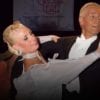BC professionals Joel & Clara Marasigan recently interviewed Simone Segatori & Annette Sudol, one of the world’s top-ranked couples. The interview shed some light on the differences between European and Canadian attitudes on practice and preparation in DanceSport and served as an eye-opening look at the criteria of top champions.
We’ve known for some time that Europeans train with a greater intensity than do most North American DanceSport competitors, particularly when compared to those on the west coast. This is something discussed often when dancers get together. But it’s doubtful that many competitors understand just how significant the difference is. Simone described in the interview that their training involves complex athletic testing that we in Canada normally associate only with the most elite athletes. “They do some tests, take some blood, measure the amount of oxygen we are using. They are checking everything,” he said. Annette explained further that “We want to be ahead of other competitors, to have done everything for our dancing — everything from the dress to physical conditioning.” And you might be surprised that they pay for this themselves!
In an interview with a top Canadian coach and adjudicator who is originally from Germany, I was told that already decades ago, Germany treated DanceSport with all the seriousness of mainstream sports. Dance competition results are televised on German sports channels and covered in the sports section of newspapers. She explained that this was never about whether DanceSport belongs in the Olympics, but just that the athleticism involved is recognized for what it is. “You have to be extremely fit to be a world-class dancer,” she said. “Taking this seriously can mean the difference between making the final or being left behind in an earlier round.
In North America, I constantly witness DanceSport treated poorly by those in the sports world. From PE teachers in high school to television producers and editors of the Sports section of newspapers, there is a foundational misunderstanding of this activity. While trying to get publicity for the 2010 SnowBall Classic, I ran into this dismissive attitude from all kinds of media people.
During the 2000 Sydney Olympic broadcast of a DanceSport demonstration in the closing ceremonies, sports broadcaster Bob Costas made snide remarks that enraged thousands of dancers.
Things haven’t changed much. A snotty editorial about DanceSport in VeloNews, the magazine of competitive cycling, led to an exchange of letters to the editor, including a follow-up letter by a reader who also dismissed the athleticism involved. These attitudes can only be changed when we as athletes begin to take training more seriously!
In January, a top professional cyclist underwent some fascinating new research on body core temperature. He acted as the guinea pig for tests that were videotaped and shared through Twitter updates. For these tests, he swallowed a special pill containing a wireless temperature transmitter that broadcast his core temperature, with an entire entourage of medical staffers studying the results minute by minute. We might associate this kind of extreme testing with only the world’s greatest athlete, but why is that? If we do so, are we not dismissing our own sport as being unimportant?
The 2010 Winter Olympic Games are just a couple weeks away, and publications are filled with information about the kind of commitment given to the training and testing of these world-class athletes. Many of these techniques apply equally well to DanceSport competitors. Completing several rounds of championship dancing in competition is equivalent to running the 800 meter sprint competitively 10-30 times in a single day!
So what kind of tests are Simone and Annette talking about?
Some are tests of blood-borne markers to optimize stamina and training methods. Yes, these involve additional costs and an associated support team such as coaches who understand what to do with the information, but Simone and Annette point out that they pay for this out of their own pocket, even in Germany. Simpler tests, such as measuring VO2 Max and heart rate, can be conducted quite inexpensively. Others involve blood analysis.
Blood borne markers
An article by Steve Norris, Ph.D., published in Impact magazine, points out some of the vital information that can be gleaned from a simple athletic blood test. A few of the blood-borne marker tests used in sports include the following:
- Glutamine/Glutamate Ratio. Glutamine is the most common free amino acid in the blood, but under high athletic stress loads, the demand exceeds the body’s ability to make it. The ratio can be used as an indicator of the body’s tolerance to training, and can be applied to designing a training program that suits the athlete’s unique needs.
- Norepinephrine. This stress hormone affects attention and the body’s response, such as heart rate and the release of glucose from energy stores. Low levels can tell an experienced coach a great deal about an athlete’s training program.
- Testosterone. This hormone has many anabolic effects. Low levels can reduce athletic performance.
- Iron. This is vital for an athlete because it affects how oxygen is transported from the lungs to muscle cells through the blood stream. Some athletes, particularly vegetarians, may not get enough iron in their diet. Intense training, through sweat and cell damage, can lead to a reduction of iron, which causes fatigue, injury and other negative factors.
- Serum Ferritin. This protein helps store iron in the body, and can show whether body iron is declining.
- Salivary Immunoglobulin-A. Present in saliva and measured through a simple saliva swab, this immunoglobulin can be depleted by intense exercise. It helps protect the lungs from infection.
- Serum Albumin. This common blood plasma protein regulates blood volume. It can increase to unhealthy levels as a result of dehydration.
In summary, there are many things DanceSport competitors can do to treat their bodies more seriously. If you expect to perform at the highest levels, you need to think and train like an athlete. If we expect the public and the media to take competitive ballroom dancing more seriously as a sport, we need to set the tone by thinking that way ourselves, as Simone & Annette do.












